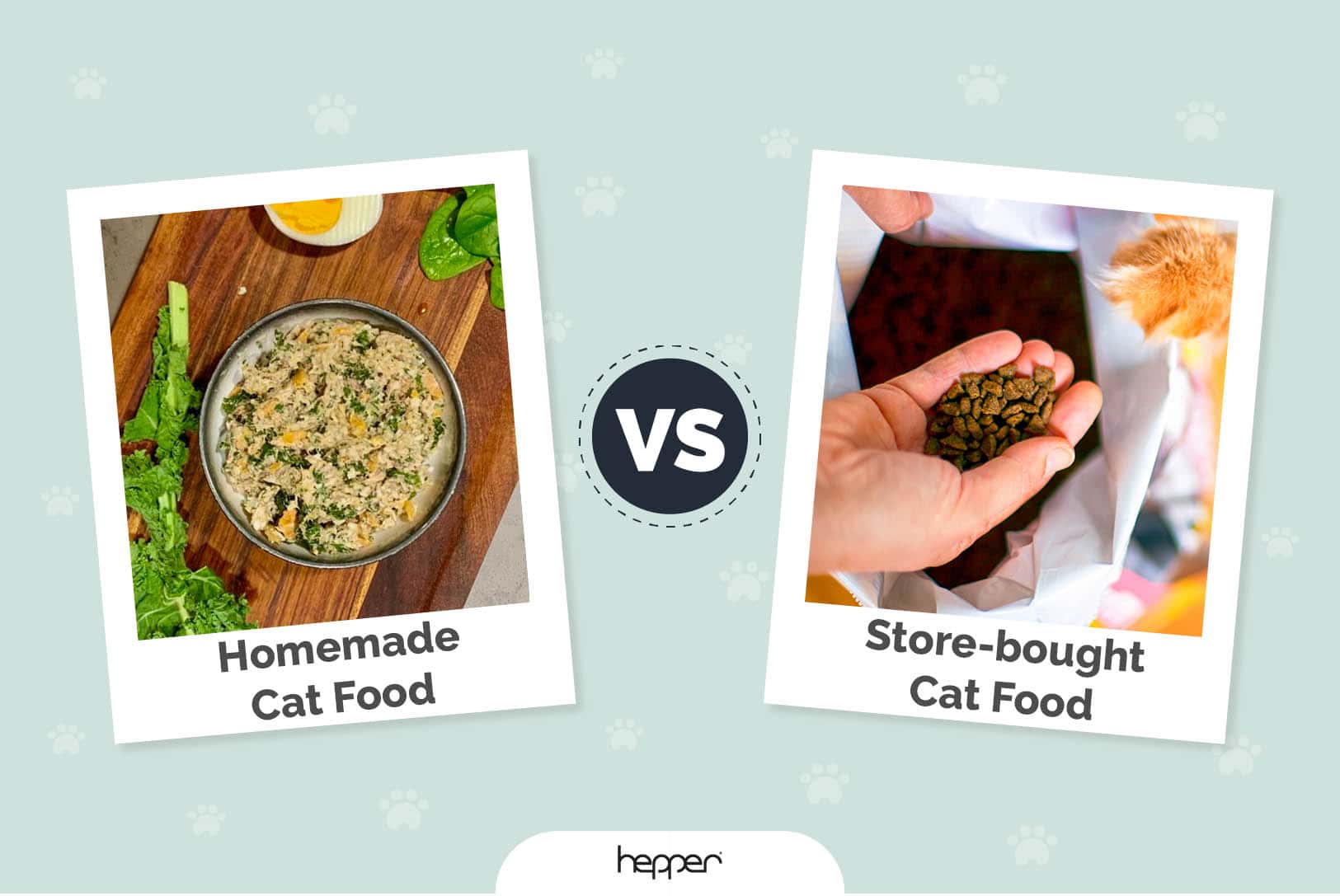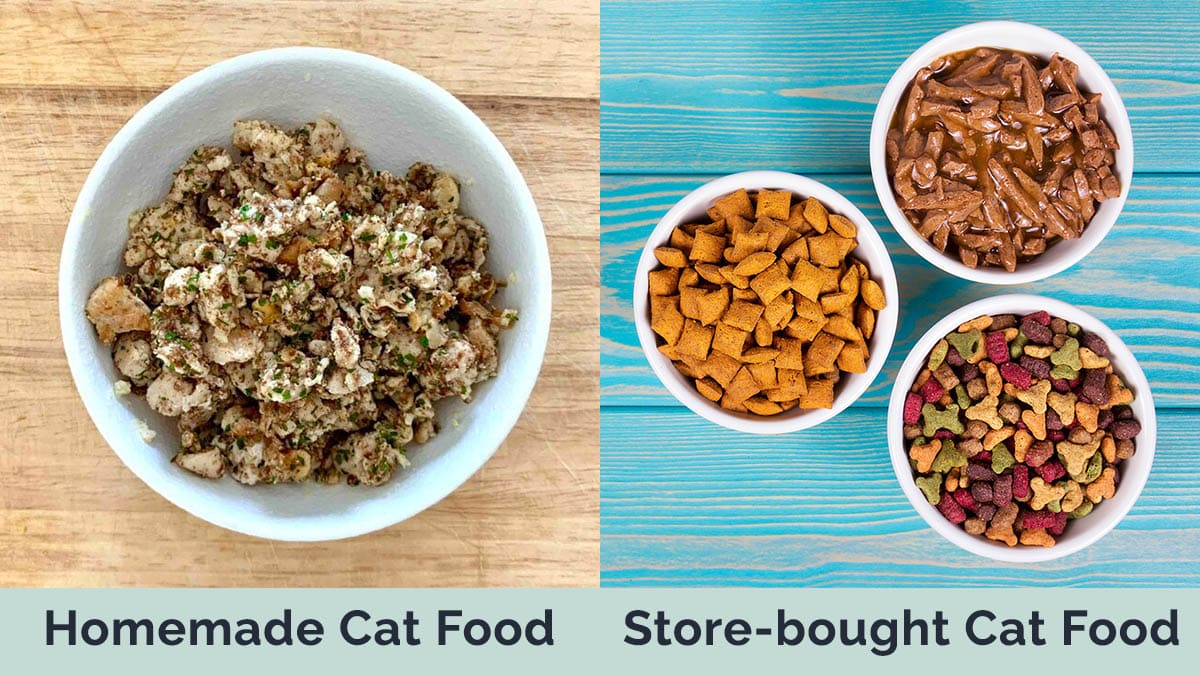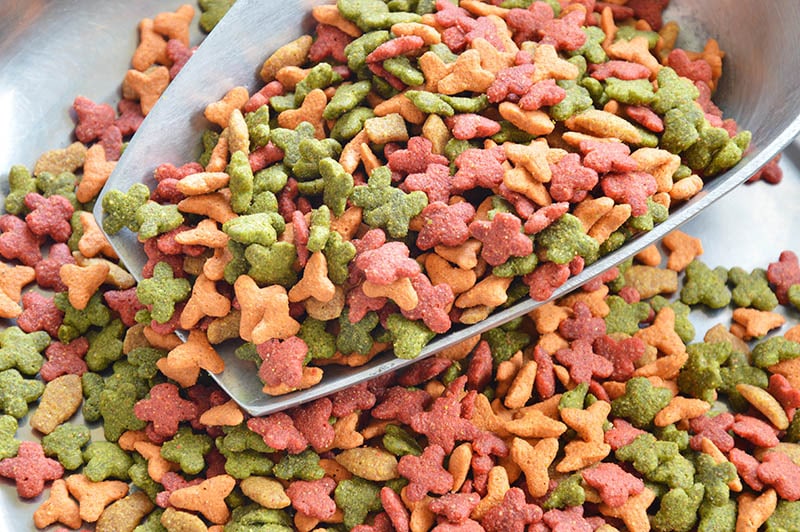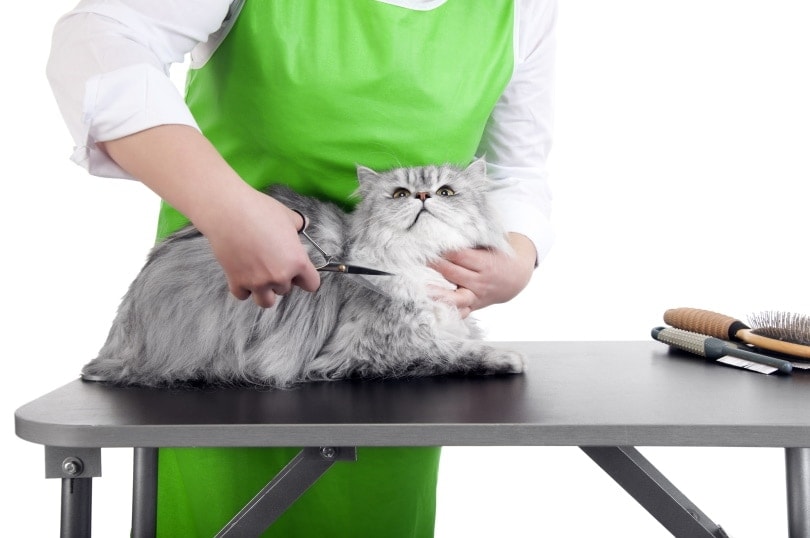Homemade vs Store-Bought Cat Food: Vet-Reviewed Pros, Cons & Verdict
Updated on

Click to Skip Ahead
In current times of cat ownership, the foods available to feed your cat have increased rapidly. There is now more choice and schools of thought regarding the best diet to feed your cat than ever before. Do you feed store-bought, raw, or homemade? Wet food or dry food? Life-stage or breed-specific diets? What you can afford consistently may also be a question you will likely consider before making your choice.
As a pet parent, the choice and sheer amount of information available can become confusing. Let’s start at the beginning and consider the pros and cons of the two popular choices: homemade vs store-bought cat food.
Visual Differences

At a Glance
- The type and source of ingredients can be controlled. Fresh and wholesome can be used
- Needs to follow a veterinary nutritionist’s recipe to prevent nutritional deficiencies
- Supplementation of certain vitamins and minerals is necessary
- Difficult and time-consuming
- These diets are complete and nutritionally balanced already. Supplementation isn’t required in healthy pets
- Convenient and readily available
- A plethora of choices and sizes with both collection and delivery options
- Not time-consuming
What Does My Cat Require in Their Food?
Nutrition is defined as a solid or liquid that is capable of nourishing a living being, allowing normal function of cells and promoting life.
The following components should be contained in any diet you feed your cat in the correct amounts:
- Protein
- Fat (lipids)
- Carbohydrates
- Vitamins A, Bs, C, D, E, and K
- Iron
- Zinc
- Selenium
- Manganese
- Phosphorus
- Magnesium
- Selenium
- Iodine
- Potassium
- Sodium
- Chloride
- Calcium
- Copper
- Water
Cats are obligate carnivores, meaning they must eat animal meat. They have two extra nutritional requirements when compared to dogs, humans, and other species, which are:
- Taurine: A particular type of essential amino acid found only in protein from animal meat.
- Arachidonic Acid: An essential fatty acid derived from animal origins.
For this reason, cats must eat animal meat and cannot be fed a vegetarian or vegan diet. Nor can these two extra necessary nutrients be added as a supplement. Failure to provide your cat with taurine and arachidonic acid results in serious health issues and complications potentially leading to their death.
Cats also require lower levels of carbohydrates as they are unable to metabolize large amounts and derive most of their energy from proteins and fats.
Overview of Homemade Cat Diets

Creating a homemade diet for your feline is not impossible but they generally are not recommended unless your veterinarian has advised this specifically due to the complexity of it, especially when there are so many other healthy commercial options available.
Should you choose to go down the homemade route, it is vital that recipes are sought from a veterinary nutritionist and followed carefully and exactly. This is to ensure all the components and nutrients your cat needs are present and provided in the correct amounts each day.
Searching online for a recipe won’t cut it! The nutritionist when compiling your recipe(s) has to take into account not only all the standard requirements but your cat’s individual needs, as well as considering factors such as lifestyle, age, breed, and general health condition.
If you are determined to feed a homemade diet, there are a few benefits:
- Fresh and wholesome ingredients can be used
- You have full control of the ingredients (the type, source, organic or not)
- Useful in cases of allergies, sensitivities, and intolerances
- Depending on the ingredients, it can be less expensive than commercial cat food
- Your cat may prefer the fresher ingredients
- Requires a nutritionist to create the right diet for your cat
- An extra expense will be incurred to consult the veterinary nutritionist
- Complicated and difficult
- Time-consuming
- Inconvenient
- If you have more than one pet, it can become impractical, as each cat will require their own version of the nutritionist’s recipe(s)
- Availability of ingredients
Overview of Store-Bought Cat Food

Commercially prepared cat foods are the preferred option due to their safety and that they contain all the nutrition your cat requires to survive and thrive. They are available in dry (kibble), semi-moist, or moist (wet/canned) formulations and cause you no concern regarding if your cat is getting all the goodness they need.
Commercial cat foods are developed over years of time and prepared by experts who have studied and worked in these arenas often for a long period of time, so you can trust the knowledge poured into these diets. If you purchase foods that have an Association of American Feed Control Officials (AAFCO) statement of nutritional adequacy on their labels, you can be sure that your cat is getting all the essential nutrients they need.
There are a plethora of choices readily found on the shelves to meet your cat’s every requirement. You would be hard-pressed not to find a suitable one for your cat, despite any health or unique issues they may have.
These diets are far more convenient, easier, and accessible at many store outlets as well as online, delivering them straight to your home. You can have the food placed on a rolling order so you never run out.
All store-bought cat food comes with a food label containing a list of their full ingredients so you can check what particulars you are feeding your cat, either because of a preference, dietary requirements, or allergies. A feeding guide is also present on all food packaging, informing you of the amount to feed your kitty each day. Remember though: treats, scraps, and toppers should still make up no more than 10% of their daily nutritional consumption and need to be factored into the amount of the diet you feed.
If you are unsure about the correct diet for your cat and/or the amounts to feed your cat, your veterinarian will happily assist you in working this out with you, or you can phone the company’s expert helpline.
- A safe choice
- Convenient
- Complete diets are offered
- No supplementation is needed unless your veterinarian has advised otherwise
- Easily stored
- Plenty of choices
- Product support
- Can be more expensive
- Too much choice and variety can lead to fussy eaters
- Canned/wet food can contribute to periodontal (dental) disease
- Preservatives are usually used
- Confusion about which to buy
- Quality can vary
Other Factors to Consider
Some cat owners have strong opinions and beliefs about the type of food and diets to feed their pets. A vegetarian owner, for example, may wish to feed a veggie diet to their cat, which is a bad idea and detrimental to the health of your pet. While the choice lies with pet parents on what you feed them, it’s also important not to impart your personal beliefs and choices onto your cat as these could cause your kitty problems. Take advice from the experts.
Newer companies are also available now that make tailored diets using fresh and good-quality ingredients. A consultation is held with you to discuss all your cat’s needs, any allergies, health issues, or preferences, and a tailored complete diet is prepared and delivered to you. This is a great option that takes into consideration any individual allergies or preferences of your cat while still being a complete diet and maintaining quality.
Regardless of the type of food your feline companion prefers, finding a bowl that is sure to keep the mess contained can be tough. Our Hepper NomNom Cat Bowl features a wide tray designed to ensure that all food stays exactly where it should—inside the bowl and off the floor. The whisker-friendly bowls fit securely into the PP plastic base and are low and wide to prevent whisker fatigue. Its contemporary style will fit seamlessly into any home and it is completely dishwasher safe.
Conclusion
Given the difficulty and potential issues surrounding homemade diets, it is recommended to use the commercial route for cat food. This ensures your cat is receiving everything they need without all the fuss of making food at home. However, the choice is up to you so long as you are offering them a complete and balanced diet.
Featured Image Credit: (L) Nicole Cosgrove, Hepper | (R) Ekaterina_Minaeva, Shutterstock













